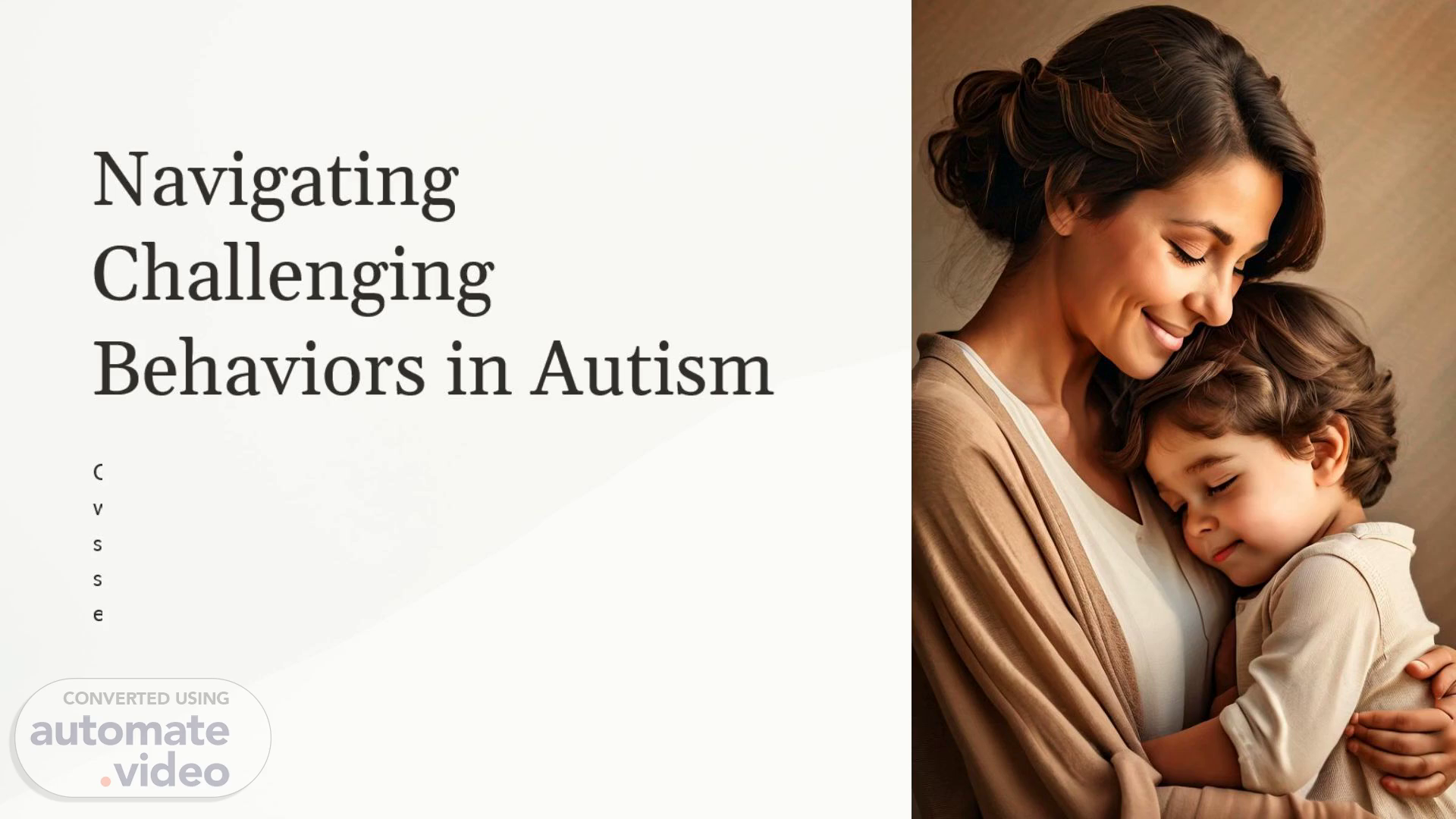
PptxGenJS Presentation
Scene 1 (0s)
Navigating Challenging Behaviors in Autism. Caring for a child with autism can present unique challenges, especially when it comes to managing disruptive or self-injurious behaviors. This section aims to provide compassionate guidance and practical strategies to support parents and caregivers in addressing these complex issues with empathy and understanding..
Scene 2 (18s)
Reasons for Self-Injurious Behavior. Self-injurious behavior in children with autism can stem from a variety of factors. It may arise from a struggle to effectively communicate emotions like anger or frustration. The child may also engage in these behaviors to seek a parent's attention or to avoid or escape from a difficult situation. In some cases, the child may participate in self-harming trends seen on social media in an attempt to fit in with their peers. Additionally, self-injury can be a way for the child to obtain sensory stimulation. Understanding the underlying reasons behind the behavior is crucial in developing effective interventions and support strategies..
Scene 3 (47s)
Prevalence and Manifestations of Self-Injurious Behavior.
Scene 4 (1m 27s)
Physical Ailments and Mental Health. Self-injurious behaviors in children with autism may not always be a form of communication. In some cases, they can be a result of underlying physical conditions or mental health concerns. For instance, a child may engage in behaviors like biting or slapping due to dental pain or abdominal discomfort. Additionally, self-injury could be linked to co-occurring mental health issues like anxiety or depression..
Scene 5 (1m 59s)
Suicidal Ideation. If your child mentions or alludes to suicide, suicidal ideation, or planning to attempt suicide, you must take them seriously. Remain calm and listen attentively as your child expresses their thoughts and feelings without interruption. Take notes to ensure you fully understand their situation. If your child discloses a specific plan to attempt suicide, your first priority is to remove any immediate threats, such as pills or knives, from the home entirely by handing them off to a trusted friend, neighbor, or family member..
Scene 6 (2m 42s)
Strategies to Decrease Self-Injurious Behavior. Validate Emotions.
Scene 7 (3m 20s)
Assess the Reason Behind Behavior. Functional Behavior Assessment.
Scene 8 (3m 59s)
Monitor the Environment. Identify Triggers. Carefully observe your child's behavior and environment to identify situations or settings that consistently trigger their self-injurious behaviors. This could be a crowded public event, a transition between activities, or a particular sensory input that causes distress..
Scene 9 (4m 35s)
Help with Communication. Find Appropriate Communication Methods.
Scene 10 (5m 17s)
Introduce Incompatible Behaviors. 1. Occupy the Hands.
Scene 11 (5m 57s)
Avoid Unintentional Reinforcement. Prevent Rewarding Behavior.
Scene 12 (6m 40s)
Provide Replacement Tools. Sensory Substitutes. If your child is engaging in self-injurious behavior due to sensory needs, introduce replacement tools they can safely chew or mouth on. This could include textured chewing toys, gum, or other mouthing-safe items that provide the sensory input they crave without causing harm..
Scene 13 (7m 19s)
Remove or Alter Triggers. Reduce Unpredictability.
Scene 14 (8m 3s)
Engage in Appropriate Activities with Friends. Identify Safe and Healthy Behaviors.
Scene 15 (8m 37s)
Additional Resources. Intervention Strategies. For parents, the Watson Institute provides detailed guidance on effective intervention strategies to decrease self-injurious behaviors in children with autism, including techniques like replacement behaviors and environmental modifications..
Scene 16 (9m 6s)
A-B-Cs Groundwork for Asking for Help. 1. Identify Interfering Behavior.
Scene 17 (9m 45s)
Steps to Teach Asking for Help. 1. Assign Tolerable Chores.
Scene 18 (10m 20s)
A-B-Cs Groundwork for Asking for a Break. Identify the Interfering Behavior.
Scene 19 (11m 1s)
Steps to Teach Asking for a Break. 1. Simulate the Trigger.
Scene 20 (11m 35s)
A-B-Cs Groundwork for Asking for Attention. Identify the Interfering Behavior.
Scene 21 (12m 23s)
Steps to Teach Asking for Attention. 1. Simulate Trigger.